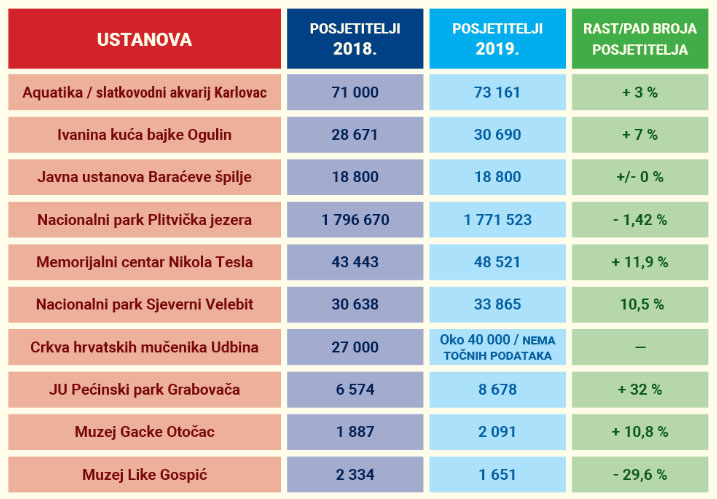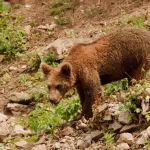February 12, 2020 – The development of continental tourism is a mantra that keeps getting repeated, but not many people realise how thoughtfully and thoroughly tourism is being developed in one region of Croatia – Lika.
The Lika Club website published their yearly tourism analysis for the region, which includes tourist workers from Karlovac County (Aquatika aquarium from Karlovac, Baraćeve Špilje and Ivana’s House of Secrets from Ogulin) and Lika-Senj County (two national parks: Plitvice Lakes and Northern Velebit, the Museum of Gacka in Otočac, the Museum of Lika in Gospić, the Nikola Tesla Museum in Smiljan, Grabovača cave park in Perušić and the largest surprise of this survey, the Church of Croatian Martyrs in Udbina (Crkva hrvatskih mučenika u Udbini).

(Screenshot from likaclub.eu; columns mean the institution, the number of visitors in 2018, number of visitors in 2019, and the relative change in the number of visitors)
The biggest tourist spot in Lika is, of course, Plitvice Lakes National Park, which has had a one and a half percent reduction in the number of visitors in 2019, compared to 2018. Ognjen Borčić, Plitvice’s PR representative says that it’s their intention to turn towards quality instead of the number of tourists. That way, the natural beauty will be preserved, the tourists would enjoy their stay more and that would lead to them staying longer. They are very satisfied with the introduction of the online system for ticket purchases which was introduced in May of last year, which helped reduce the crowds. Margarita Markušić Kulaš, the director of Karlovac’s Aquatika aquarium says that they are extremely satisfied with the growth in the number of visitors, and in 2020, their focus is on numerous events which are to be held in the aquarium.
The Museum of Lika in Gospić and the Nikola Tesla Museum in Smiljan are a couple of kilometres away from one another and have the same management. Their manager, Tatjana Kolak, explained that, while the Museum of Lika had a large reduction of the number of visitors in 2019, their overall numbers have improved. For the first time ever, they have crossed the number of 50 thousand visitors, and they’re very proud of that record.
The neighbouring museum with similar characteristics, the Museum of Gacka in Otočac, saw growth in their numbers of around 10 percent. They’re getting ready for the new year, they printed a promotional brochure with neighbouring sites to visit and they have an audio guide which they plan to translate into English, to make it more accessible to foreign visitors. Baraćeve špilje (caves) has maintained the same number of visitors, but soon they’ll start building their visitor’s centre dedicated to the underground heritage SPELEON, financed by the EU. The only cave park in Croatia, Grabovača in Perušić saw the biggest relative growth of over 30 percent. Jelena Milković, the manager, talks about their plans to expand their promotional activities, and open a garden with edible herbs. They also plan to invest more in educational activities and determine exactly how many visitors can come into the Samograd cave without devastation to life within the cave.
Northern Velebit National Park is very satisfied with their growth of around 10 percent, and especially proud of how many people want to visit their House of the Velebit. They are investing a lot in promotion, and they have plans to expand that promotion to foreign markets.








